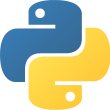 Language
Language
- Python 3
 Reading time
Reading time
- Approximately 55 days
 What you will learn
What you will learn
- Web Development
 Author
Author
- Daniel Roy Greenfeld
 Published
Published
- 8 years ago
 Packages you will be introduced to
Packages you will be introduced to
- django
Two Scoops of Django 1.11 Will Help You Build Django Projects.
In this book we introduce you to the various tips, tricks, patterns, code snippets, and techniques that we've picked up over the years. We have put thousands of hours into the fourth edition of the book, writing and revising its material to include significant improvements and new material based on feedback from previous editions.
Table of Contents
- Chapter 1: Coding Style
- Chapter 2: The Optimal Django Environment Setup
- Chapter 3: How To Lay Out Django Projects
- Chapter 4: Fundamentals of Django App Design
- Chapter 5: Settings and Requirements Files
- Chapter 6: Model Best Practices
- Chapter 7: Queries and the Database Layer
- Chapter 8: Function- and Class-Based Views
- Chapter 9: Best Practices for Function-Based Views
- Chapter 10: Best Practices for Class-Based Views
- Chapter 11: Form Fundamentals
- Chapter 12: Common Patterns for Forms
- Chapter 13: Templates: Best Practices
- Chapter 14: Template Tags and Filters
- Chapter 15: Django Templates and Jinja2
- Chapter 16: Building APIs with Django Rest Framework
- Chapter 17: Consuming REST APIs
- Chapter 18: Tradeoffs of Replacing Core Components
- Chapter 19: Working With the Django Admin
- Chapter 20: Dealing with the User Model
- Chapter 21: Django's Secret Sauce: Third-Party Packages
- Chapter 22: Testing Chapter of Doom!
- Chapter 23: Documentation: Be Obsessed
- Chapter 24: Finding and Reducing Bottlenecks
- Chapter 25: Asynchronous Task Queues
- Chapter 26: Security Best Practices
- Chapter 27: Logging: Tips and Tools
- Chapter 28: Signals: Use Cases and Avoidance Techniques
- Chapter 29: What About Those Random Utilities?
- Chapter 30: Deployment: Platforms as a Service
- Chapter 31: Deploying Django Projects
- Chapter 29: Identical Environments: The Holy Grail
- Chapter 32: Continuous Integration
- Chapter 33: The Art of Debugging
- Chapter 34: Where and How to Ask Django Questions
- Chapter 35: Closing Thoughts
- Appendix A: Packages Mentioned In This Book
- Appendix B: Troubleshooting
- Appendix C: Additional Resources
- Appendix D: Internationalization and Localization
- Appendix E: Settings Alternatives
- Appendix F: Working with Python 2
- Appendix G: Channels and Websockets
What People Say About Two Scoops of Django
- This is the swiss army knife for every Django developer. -- Jannis Gebauer, djangopackages.org maintainer and pyup.io founder
- We buy this book for every new engineer on our team. It's a must for Django development! -- Jacinda Shelly, CTO of Doctor On Demand
- I wanted to write a book about best practices in Django, except Two Scoops is that book, no need to write another one. -- Buddy Lindsey, Host of GoDjango
- Audrey's illustrations reinforce Audrey and Daniel's Django technical excellence. (Art + ice cream) * 2 tech experts = Two Scoops of Django. -- Carol Willing, Project Jupyter Core Dev and Python Software Foundation director
- Simply the best book on Django. Whenever I am not sure if I am following the best practices, I look up the topic in this book. A must read. -- Abu Ashraf Masnun, programmer
The author Daniel Roy Greenfeld has the following credentials.
- Prominent person behind the well known Python package cookiecutter
- Works/Worked at NASA
